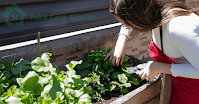Urban Garden Planning: Cultivating Nature in Urban Spaces
Urban garden planning is an essential approach to transforming limited urban spaces into oases of greenery and sustainability. In an increasingly urban world, where space is a precious resource, creating vegetable gardens in urban environments offers numerous benefits, from access to fresh food to promoting biodiversity. In this article, we will explore the essential steps for planning successful urban gardens.
Why Plan Urban Gardens?
Planning urban gardens is crucial for several reasons:
- Efficient Use of Space: In urban areas, space is limited and expensive. Proper planning allows you to make the most of the available space.
- Sustainability: Planning can include sustainable practices, such as composting, efficient use of water and organic farming, contributing to a healthier environment.
- Biodiversity: Consciously planned gardens can attract pollinators, birds and other animals, promoting biodiversity in urban environments.
- Aesthetics: Careful planning creates attractive and harmonious spaces, improving the quality of life and aesthetics of urban areas.
- Access to Fresh Food: Well-planned gardens provide access to fresh, healthy foods, contributing to food security in urban communities.
Steps for Urban Garden Planning
Here are the essential steps for planning urban gardens:
1. Choosing the Location
Identifying the ideal location for your vegetable garden is the first step. Consider the availability of sunlight, access to water and the proximity of the garden to residents or the community.
2. Define the Objectives
Determine the goals of your urban garden. Do you want to grow food, medicinal herbs, flowers or create a leisure space? Defining objectives will help guide planning.
3. Layout Planning
Draw a layout for your vegetable garden. Consider the arrangement of bedding, the location of trails, fences, supports and rest areas. A good layout optimizes the use of space and makes plant care easier.
4. Choosing Plants
Select the plants you want to grow based on your climate, soil and goals. Be sure to choose varieties suited to your space and region.
5. Soil Preparation
Prepare the soil properly by incorporating organic matter, such as compost, to improve soil fertility and structure. Test the pH and adjust as needed.
6. Choosing Cultivation Methods
Decide whether you will use traditional soil growing methods, hydroponics or aeroponics systems, or vertical growing techniques. The choice depends on available space and resources.
7. Sustainable Implementation
Promote sustainable farming practices such as efficient use of water, recycling organic waste, and minimizing the use of pesticides and herbicides.
8. Regular Maintenance
Maintain your garden regularly, watering, pruning, fertilizing and controlling pests as necessary. Proper maintenance is essential to the success of your urban garden.
9. Engage the Community
Encourage community participation in your urban garden. This may include educational activities, community harvest events, or volunteering.
10. Monitoring and Evaluation
Track the progress of your garden and measure success against your goals. Make adjustments as needed to improve performance.
Tips for Successful Urban Garden Planning
- Choose plant varieties adapted to your climate and space.
- Use sustainable materials like reclaimed wood to build raised beds or fences.
- Consider including seating and shade areas to make your vegetable garden more enjoyable.
- Implement water-saving techniques such as drip irrigation systems.
- Keep a log of gardening activities to learn from successes and challenges.
1. What is urban garden planning?
Urban garden planning is the process of conceiving, organizing and designing spaces where edible plants, such as fruits, vegetables and herbs, will be grown in urban environments.
2. Why is it important to plan an urban garden?
Planning is crucial to ensure the efficient use of space, choosing the appropriate plants, optimizing sun exposure, defining irrigation and ensuring that the garden meets the needs and objectives of the grower.
3. What are the basic steps for planning an urban garden?
The steps include selecting the site, analyzing sunlight conditions, choosing plants, preparing the soil, defining the irrigation system and creating a maintenance plan.
4. How to choose the ideal location for an urban garden?
The location must receive at least 6 hours of direct sunlight per day, be close to a water source and be easily accessible for caring for plants and harvesting food.
5. What types of plants are ideal for urban gardens?
Herbs like basil, rosemary and parsley are popular, as are fast-growing vegetables like lettuces and radishes. The choice must take into account space and local conditions.
6. How to prepare the soil for an urban garden?
The soil must be enriched with organic compost to provide nutrients to the plants. Additionally, it is important to ensure good drainage and a suitable pH for the plants you want to grow.
7. How important is irrigation in an urban garden?
Proper irrigation is essential for healthy plant growth. You can use drip irrigation systems, watering cans, or even a garden hose, depending on the size of your vegetable garden.
8. How to avoid pests and diseases in urban gardens?
Plant diversification, crop rotation and the use of organic pest control techniques, such as introducing predatory insects, can help reduce pest and disease problems.
9. What additional resources can help with planning an urban garden?
Books, online courses, community gardening groups, and consultations with urban gardening experts can provide valuable guidance during planning.
10. What are the benefits of a well-planned urban garden?
Benefits include access to fresh, healthy food, reduced carbon footprint, improved air quality, saving money and connecting with nature, even in urban areas.
Conclusion
Planning urban gardens is an effective way to bring nature into the heart of urban areas. By following the steps and tips mentioned in this article, you will be well on your way to creating a productive, sustainable, and vibrant urban garden. Remember that careful planning is the key to success, allowing you to make the most of available space and promote biodiversity, sustainability and connection to nature in your urban community.


